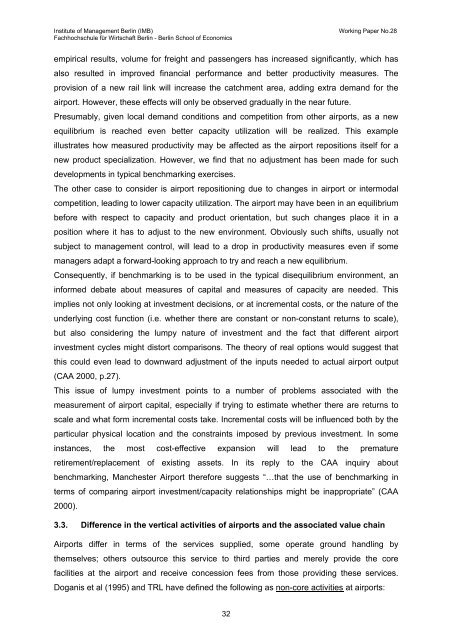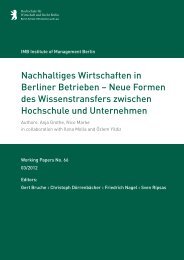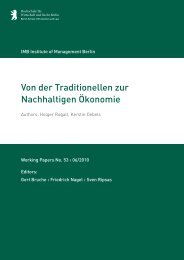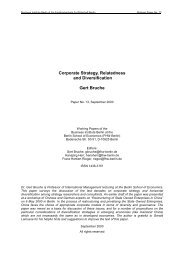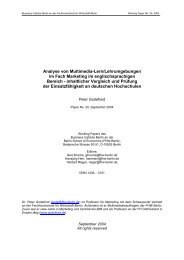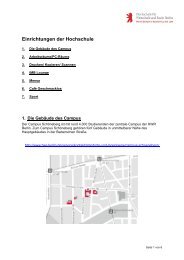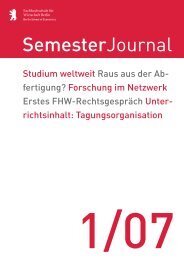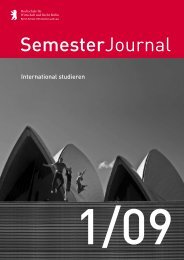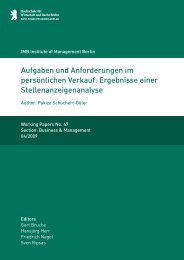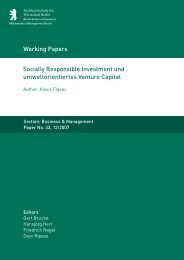Working paper template - MBA Programme der HWR Berlin
Working paper template - MBA Programme der HWR Berlin
Working paper template - MBA Programme der HWR Berlin
Create successful ePaper yourself
Turn your PDF publications into a flip-book with our unique Google optimized e-Paper software.
Institute of Management <strong>Berlin</strong> (IMB) <strong>Working</strong> Paper No.28<br />
Fachhochschule für Wirtschaft <strong>Berlin</strong> - <strong>Berlin</strong> School of Economics<br />
empirical results, volume for freight and passengers has increased significantly, which has<br />
also resulted in improved financial performance and better productivity measures. The<br />
provision of a new rail link will increase the catchment area, adding extra demand for the<br />
airport. However, these effects will only be observed gradually in the near future.<br />
Presumably, given local demand conditions and competition from other airports, as a new<br />
equilibrium is reached even better capacity utilization will be realized. This example<br />
illustrates how measured productivity may be affected as the airport repositions itself for a<br />
new product specialization. However, we find that no adjustment has been made for such<br />
developments in typical benchmarking exercises.<br />
The other case to consi<strong>der</strong> is airport repositioning due to changes in airport or intermodal<br />
competition, leading to lower capacity utilization. The airport may have been in an equilibrium<br />
before with respect to capacity and product orientation, but such changes place it in a<br />
position where it has to adjust to the new environment. Obviously such shifts, usually not<br />
subject to management control, will lead to a drop in productivity measures even if some<br />
managers adapt a forward-looking approach to try and reach a new equilibrium.<br />
Consequently, if benchmarking is to be used in the typical disequilibrium environment, an<br />
informed debate about measures of capital and measures of capacity are needed. This<br />
implies not only looking at investment decisions, or at incremental costs, or the nature of the<br />
un<strong>der</strong>lying cost function (i.e. whether there are constant or non-constant returns to scale),<br />
but also consi<strong>der</strong>ing the lumpy nature of investment and the fact that different airport<br />
investment cycles might distort comparisons. The theory of real options would suggest that<br />
this could even lead to downward adjustment of the inputs needed to actual airport output<br />
(CAA 2000, p.27).<br />
This issue of lumpy investment points to a number of problems associated with the<br />
measurement of airport capital, especially if trying to estimate whether there are returns to<br />
scale and what form incremental costs take. Incremental costs will be influenced both by the<br />
particular physical location and the constraints imposed by previous investment. In some<br />
instances, the most cost-effective expansion will lead to the premature<br />
retirement/replacement of existing assets. In its reply to the CAA inquiry about<br />
benchmarking, Manchester Airport therefore suggests “…that the use of benchmarking in<br />
terms of comparing airport investment/capacity relationships might be inappropriate” (CAA<br />
2000).<br />
3.3. Difference in the vertical activities of airports and the associated value chain<br />
Airports differ in terms of the services supplied, some operate ground handling by<br />
themselves; others outsource this service to third parties and merely provide the core<br />
facilities at the airport and receive concession fees from those providing these services.<br />
Doganis et al (1995) and TRL have defined the following as non-core activities at airports:<br />
32


